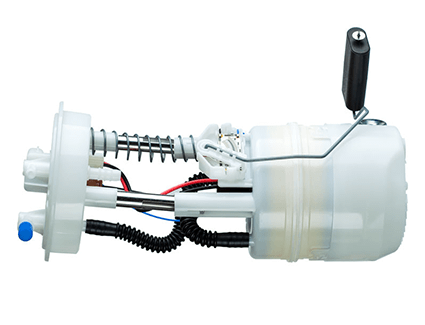

There are some folks who don't need to know anything about their fuel system other than that the car goes when the tank has gas. That's fine for some, but if you've ever wondered how exactly the fuel system works, we're here to provide valuable information! On this page, we'll walk you through five vital components of your vehicle's fuel system, giving you a general overview of how things work.
One important note before we start. This page will be looking exclusively at fuel injection systems. If you drive a car that was made within the last 30 years or so, it's almost certain that your fuel system is of this type. However, drivers of vintage cars from before the late 1980s may have carbureted systems, instead. These work slightly differently, but the general idea is the same.

5. Fuel Tank
The fuel tank is where our journey begins. The most basic function of the fuel tank, of course, is to store gasoline until it's ready to be used. However, that's not all that it does. Inside the tank, you'll find a sending unit that lets you know how much gas is in the tank. This sending unit, often comprised of a float on a metal arm that's attached to a resistor, sends a signal to the fuel gauge in your vehicle's instrument cluster.

4. Fuel Pump
The fuel pump takes the gasoline from the tank and begins to move it through the rest of the fuel system. In older vehicles, you're likely to find a mechanical pump that's placed outside of the gas tank. However, modern cars usually have electric pumps that are often located within the tank itself. These newer pumps help improve fuel efficiency in today's sophisticated, high-compression engines.
3. Fuel Filter
The fuel filter does exactly what it sounds like: it filters the fuel. More specifically, if any particles of rust, sediment, or other contaminants are present in your gas tank, the fuel filter makes sure they don't get through to the rest of the system. This is vital, since particles like this could damage the engine. The fuel filter could be placed in the tank itself, or it may be in the fuel lines.

2. Fuel Lines & Fuel Rail
Once the gasoline has been pumped from the tank and passed through the filter, it continues its journey towards the engine. It's transported through fuel lines that run from the tank to the engine and are usually made from either metal or reinforced rubber. At the end of the line, the fuel lines go to the fuel rail. On the rail are mounted the next and final components of the system.
1. Fuel Injectors
The fuel injectors sit on the fuel rail, and they're responsible for injecting fuel into the engine's combustion chambers. Fuel injectors are controlled by a computer to ensure top efficiency. Based on input from this computer, they'll spray a precise amount of gasoline into the tank, while a certain amount of air is also let through. Once the gasoline is in the combustion chambers, it will power your engine!
Contact
2855 Maple Ave Ne
2855 Maple Ave Ne
Salem, OR 97301
- Contact: (503) 877-2943
Hours
- Monday 9:00 am - 8:00 pm
- Tuesday 9:00 am - 8:00 pm
- Wednesday 9:00 am - 8:00 pm
- Thursday 9:00 am - 8:00 pm
- Friday 9:00 am - 8:00 pm
- Saturday 9:00 am - 8:00 pm
- Sunday 10:00 am - 7:00 pm

